The daily life
of Roman citizens depended on their status in society. And nowhere
has revealed more about everyday life than the remains of
Herculaneum, an ancient Roman town in modern-day Ercolano, Italy,
buried by volcanic ash and pumice during the catastrophic eruption
of Mount Vesuvius.
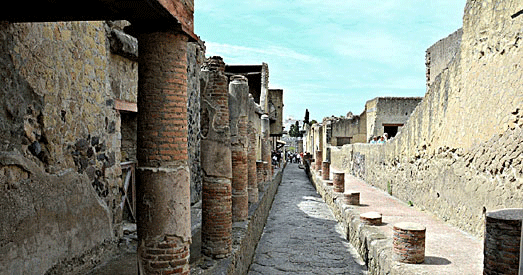
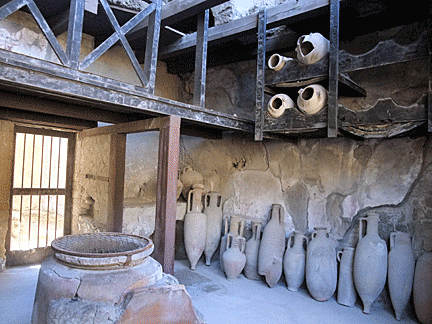 Archaeologists
believe the date of the eruption to be on or after October 17, 79 CE
because the people buried in the ash were wearing heavier clothing
than the light summer clothes typical of August, plus preserved
remains of fresh fruit and vegetables in the shops were typical of
October. Wine fermenting jars had been sealed, which would have
happened around the end of October. Also, coins discovered in the
purse of a woman buried in the ash include one with a 15th Imperial
acclamation among the Emperor's titles which couldn’t have been
minted before the second week of September.
Archaeologists
believe the date of the eruption to be on or after October 17, 79 CE
because the people buried in the ash were wearing heavier clothing
than the light summer clothes typical of August, plus preserved
remains of fresh fruit and vegetables in the shops were typical of
October. Wine fermenting jars had been sealed, which would have
happened around the end of October. Also, coins discovered in the
purse of a woman buried in the ash include one with a 15th Imperial
acclamation among the Emperor's titles which couldn’t have been
minted before the second week of September.
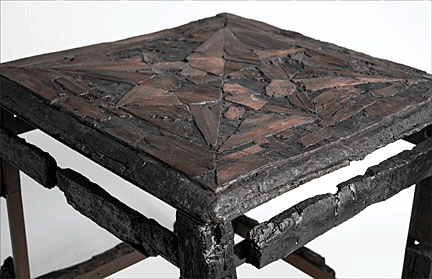 Unlike
Pompeii, which was primarily buried under volcanic ash, Herculaneum
was engulfed by a series of pyroclastic flows. These surges were
fast-moving clouds of hot gas, ash, and volcanic material that
descended from the volcano at incredibly high temperatures, reaching
up to 932°F. Over 60 feet of volcanic materials buried the city,
preserving it for centuries. The thick layers of pyroclastic
material that covered Herculaneum
Unlike
Pompeii, which was primarily buried under volcanic ash, Herculaneum
was engulfed by a series of pyroclastic flows. These surges were
fast-moving clouds of hot gas, ash, and volcanic material that
descended from the volcano at incredibly high temperatures, reaching
up to 932°F. Over 60 feet of volcanic materials buried the city,
preserving it for centuries. The thick layers of pyroclastic
material that covered Herculaneum
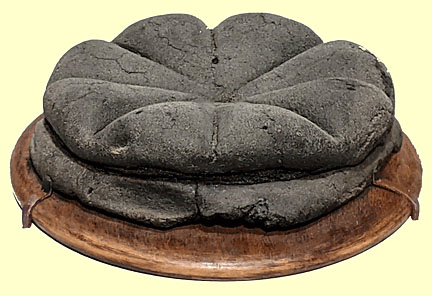 carbonized
and preserved wooden objects such as roofs, beds, and doors, as well
as other organic-based materials such as food and papyrus. This
level of preservation has provided invaluable insights into daily
life in an ancient Roman city.
carbonized
and preserved wooden objects such as roofs, beds, and doors, as well
as other organic-based materials such as food and papyrus. This
level of preservation has provided invaluable insights into daily
life in an ancient Roman city.
A farmer drilling a well rediscovered Herculaneum by chance in 1709.
Remnants of the city, however, had already been found during earlier
earthworks. In the years following the site's uncovering, treasure
seekers excavated tunnels and took artifacts. Regular excavations
commenced in 1738 and have continued irregularly ever since.
Herculaneum grew into a prosperous seaside retreat, attracting
wealthy Romans who built luxurious villas there, drawn by the city’s
seaside location and beautiful surroundings. The city thrived under
the Roman Empire, with its elite citizens enjoying a high standard
of living.
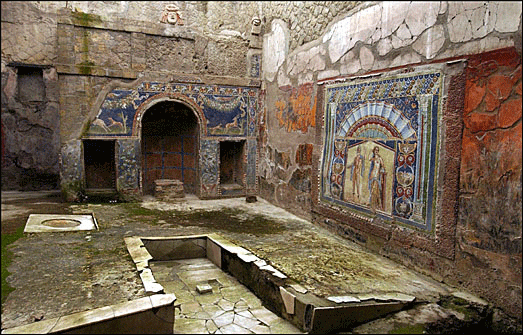
The grand villas, which often included private baths, triclinia
(dining rooms), and beautifully decorated atriums, were decorated
with frescoes, intricate mosaics, and opulent furnishings..
Layout and Infrastructure
Being much smaller than
Pompeii, Herculaneum had a population of only 4,000 to 5,000 people.
City planners created a well-organized grid pattern of streets,
featuring a mix of residential, commercial, and public buildings.
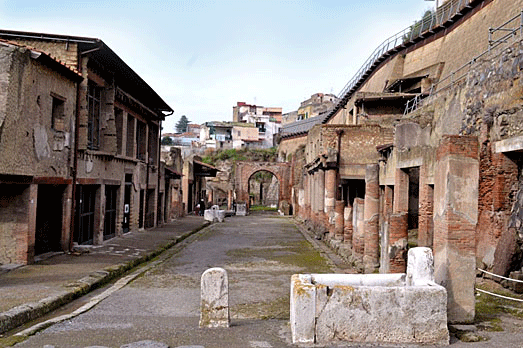
Because of its smaller size and wealth, Herculaneum enjoyed some
advantages in terms of infrastructure. High-quality stone paved the
city’s streets. And a sophisticated water system, regulated by
valves, brought fresh water to homes through lead pipes connected to
the Serino Aqueduct. Public baths, fountains, and elaborate drainage
systems demonstrated the city’s Roman engineering prowess.
Daily Life in Herculaneum
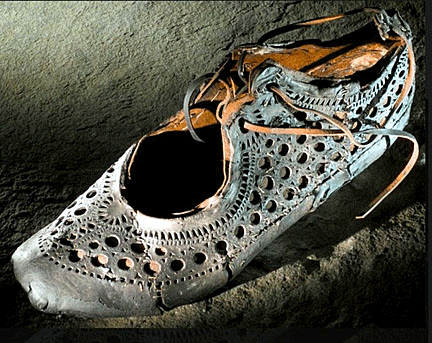 Life
in Herculaneum, like other Roman cities, revolved around public and
private activities. The city had forums, markets, and baths where
citizens gathered for social, political, and commercial purposes.
The public baths were not only places for bathing but also centers
of social life, where people could meet, relax, and discuss the
affairs of the day.
Life
in Herculaneum, like other Roman cities, revolved around public and
private activities. The city had forums, markets, and baths where
citizens gathered for social, political, and commercial purposes.
The public baths were not only places for bathing but also centers
of social life, where people could meet, relax, and discuss the
affairs of the day.
Generally, the
citizens of Herculaneum began their day before sunrise. Living in a
time before electric light, all Roman citizens made the most out of
their day and completed all business before sundown. They wasted no
time getting ready in the morning. Their breakfasts usually
consisted of only a glass of water. They saved washing for the
afternoon when they would visit the thermae, or local
bathhouse. They filled in the time until supper by strolling,
exercising, or gambling.
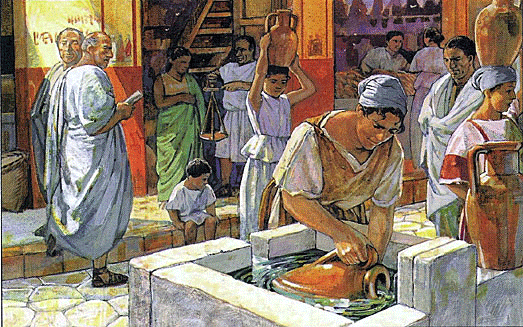
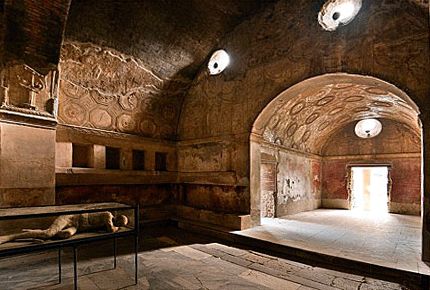 Children
entered the bathhouses free of charge, while adults paid around half
a cent, a microscopic sum. The thermae offered every type of
bath that ingenuity could devise--- hot baths, cold baths, hot air
baths, and swimming pools. Most baths also included enclosed
gardens, promenades, and space to exercise. The Romans practiced
several sports, including a type of tennis played with the palm of
the hand instead of a racquet, and a ball game called harpastum
that was somewhat comparable to rugby.
Children
entered the bathhouses free of charge, while adults paid around half
a cent, a microscopic sum. The thermae offered every type of
bath that ingenuity could devise--- hot baths, cold baths, hot air
baths, and swimming pools. Most baths also included enclosed
gardens, promenades, and space to exercise. The Romans practiced
several sports, including a type of tennis played with the palm of
the hand instead of a racquet, and a ball game called harpastum
that was somewhat comparable to rugby.
The thermae
received water, heated via a complex of furnaces hidden within the
walls or under the floors, through the city’s aqueducts. Even the
simplest bathhouse was a feat of engineering and a welcoming
backdrop for socializing .
The baths closed at sundown, though most left before that, so they
would have ample time to eat. Supper was the most important meal in
a Roman’s day, considering breakfast consisted of water and lunch of
bread with cheese and cold cuts. For patricians, supper could last
anywhere between one and four hours. Banquets held in the most
lavish villas could last until midnight or after.
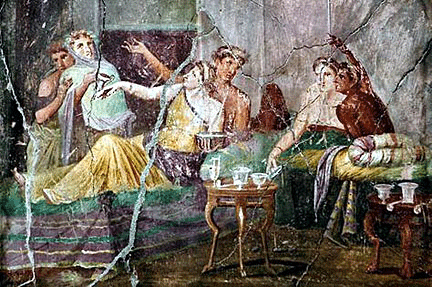 Wealthier
Romans ate supper in a triclinium, or dining room, which
contained not tables and chairs but reclining couches arranged
around square tables where the food would be laid out by slaves.
Willing and able to defy the forces of gravity, Romans ate while
lying on their left side, their weight supported on one arm while
they used the other consume food.
Wealthier
Romans ate supper in a triclinium, or dining room, which
contained not tables and chairs but reclining couches arranged
around square tables where the food would be laid out by slaves.
Willing and able to defy the forces of gravity, Romans ate while
lying on their left side, their weight supported on one arm while
they used the other consume food.
Slaves performed almost all of the menial jobs as well as many of
the professions such as teachers, doctors, surgeons, and architects.
Most of the freedmen worked at various trades, for example, as
bakers, fishmongers, or carpenters. Occasionally, poor women would
serve the affluent as hairdressers, midwives, or dressmakers.
Those who didn’t live in villas, the middle class, resided in an
insula, a tall apartment building. The floor on which a person
lived depended on their income. The apartments on the ground or
first floor were far more comfortable than those on the top floors.
They were spacious, containing separate rooms for dining and
sleeping, had glazed windows, and, unlike the other floors, the
persons living there paid their rent annually.
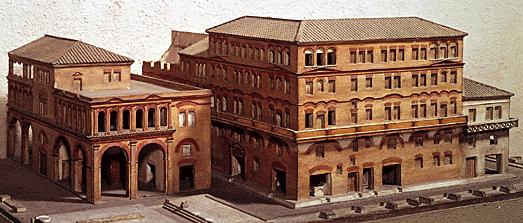
Those living on the higher floors paid rent by the day or week for a
cramped space, often with only one room to a family. Families on
upper floors lived in constant fear of eviction. They had no access
to natural light, were hot in the summer and cold in the winter, and
had little or no running water, thus no latrina or toilet.
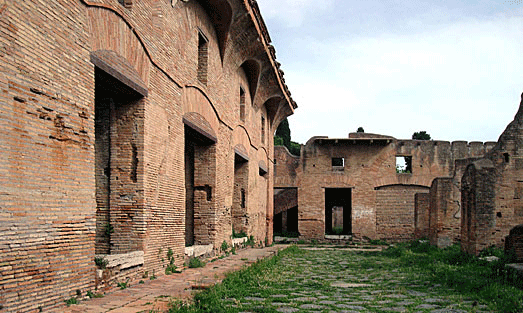
 Those
who lived in the insulae, especially those living on the
lower floors, often didn’t have cooking facilities, so many would
frequent one of the many thermopolia—the Roman version of a
fast-food outlet that catered to Romans in need of quick, affordable
meals. Four to six large dolia, terracotta containers that
once held hot meals such as chickpeas, beans, and dried fruit were
inset into the counter of the thermopolium.
Those
who lived in the insulae, especially those living on the
lower floors, often didn’t have cooking facilities, so many would
frequent one of the many thermopolia—the Roman version of a
fast-food outlet that catered to Romans in need of quick, affordable
meals. Four to six large dolia, terracotta containers that
once held hot meals such as chickpeas, beans, and dried fruit were
inset into the counter of the thermopolium.
Wealthier middle
class Romans, who didn’t live in villas outside the city, lived in
large homes called a domus. These houses had many rooms,
including a courtyard, or atrium, beautifully decorated with mosaics
and statues, which was the center of family life. As with many of
the tenements, the front of this dwelling often contained a shop
where the owner would conduct daily business. Behind the shop was
the atrium, a reception area where they could greet guests or
clients and sometimes conduct private business.
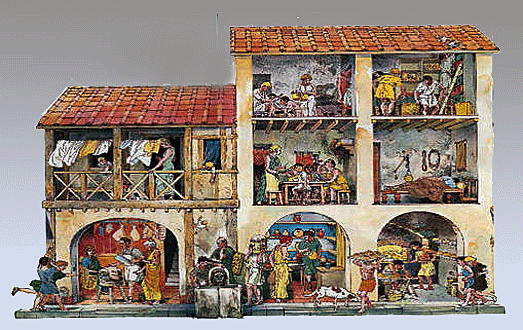
The atrium would often contain a small shrine to a household or
ancestral god. The ceiling of the atrium was open and beneath this
was a rectangular pool. On rainy days the water that came through
this opening was collected and used elsewhere in the domus.
On either side of the atrium were smaller rooms, called cubiculum,
which served as bedrooms, libraries and offices. Of course, there
was ample space available for a triclinium and the kitchen.
The family garden lie at the rear of the home.
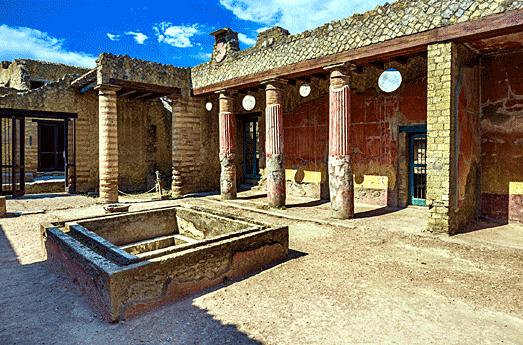
The home was the domain of the wife. While she was initially
restricted from appearing in public, she ran the household and often
saw to the education of the children until a tutor could be found.
By the end of the Republic, she was even permitted to sit with her
husband at dinner, go to the baths, although not at the same time as
the men, and attend the theater and games.
Roman Baths
After a busy day conducting business and attending the games, a
Roman citizen needed to relax at the baths. Bathing was important to
all Romans who visited the baths usually once or twice a week. The
baths were a place to socialize and sometimes conduct business.
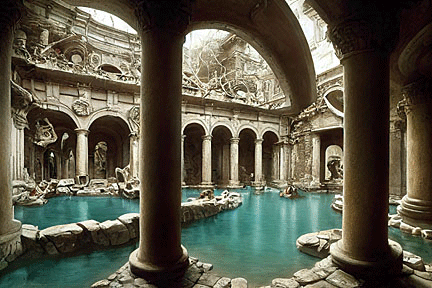
A typical bath included a gym, health center, swimming pool and
sometimes even a bordello for the weathier guests. Most were
very cheap to use and even free on public holidays. A typical bath
would have three rooms---a tepidarium or relaxation room, a
caldarium or hotter room, and a frigadarium or cooling room.
Slaves maintained the heat in the various hot rooms as well as
attended to the needs of the wealthy.
Herculaneum’s public baths are remarkably well-preserved, with much
of the original decoration intact. The baths provide a glimpse into
Roman bathing culture, with separate areas for men and women.
